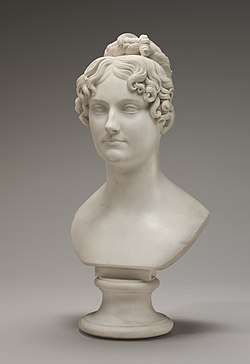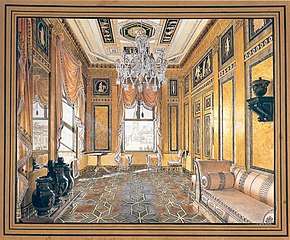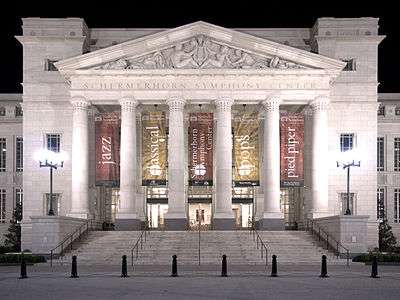Neoclassicism
Neoclassicism (also spelled Neo-classicism; from Greek νέος nèos, "new" and Greek κλασικός klasikόs, "of the highest rank")[1] was a Western cultural movement in the decorative and visual arts, literature, theatre, music, and architecture that drew inspiration from the art and culture of classical antiquity. Neoclassicism was born in Rome largely thanks to the writings of Johann Joachim Winckelmann, at the time of the rediscovery of Pompeii and Herculaneum, but its popularity spread all over Europe as a generation of European art students finished their Grand Tour and returned from Italy to their home countries with newly rediscovered Greco-Roman ideals.[2][3] The main Neoclassical movement coincided with the 18th-century Age of Enlightenment, and continued into the early 19th century, laterally competing with Romanticism. In architecture, the style continued throughout the 19th, 20th and up to the 21st century.
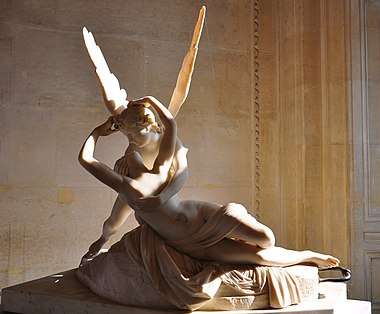
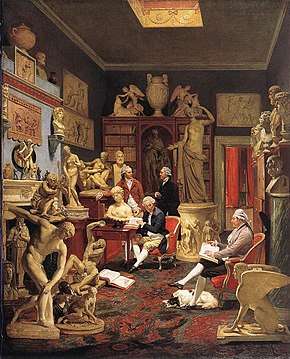
European Neoclassicism in the visual arts began c. 1760 in opposition to the then-dominant Rococo style. Rococo architecture emphasizes grace, ornamentation and asymmetry; Neoclassical architecture is based on the principles of simplicity and symmetry, which were seen as virtues of the arts of Rome and Ancient Greece, and were more immediately drawn from 16th-century Renaissance Classicism. Each "neo"-classicism selects some models among the range of possible classics that are available to it, and ignores others. The Neoclassical writers and talkers, patrons and collectors, artists and sculptors of 1765–1830 paid homage to an idea of the generation of Phidias, but the sculpture examples they actually embraced were more likely to be Roman copies of Hellenistic sculptures. They ignored both Archaic Greek art and the works of Late Antiquity. The "Rococo" art of ancient Palmyra came as a revelation, through engravings in Wood's The Ruins of Palmyra. Even Greece was all-but-unvisited, a rough backwater of the Ottoman Empire, dangerous to explore, so Neoclassicists' appreciation of Greek architecture was mediated through drawings and engravings, which subtly smoothed and regularized, "corrected" and "restored" the monuments of Greece, not always consciously.
The Empire style, a second phase of Neoclassicism in architecture and the decorative arts, had its cultural centre in Paris in the Napoleonic era.
History
Neoclassicism is a revival of the many styles and spirit of classic antiquity inspired directly from the classical period,[4] which coincided and reflected the developments in philosophy and other areas of the Age of Enlightenment, and was initially a reaction against the excesses of the preceding Rococo style.[5] While the movement is often described as the opposed counterpart of Romanticism, this is a great over-simplification that tends not to be sustainable when specific artists or works are considered. The case of the supposed main champion of late Neoclassicism, Ingres, demonstrates this especially well.[6] The revival can be traced to the establishment of formal archaeology.[7][8]
.jpg)
The writings of Johann Joachim Winckelmann were important in shaping this movement in both architecture and the visual arts. His books Thoughts on the Imitation of Greek Works in Painting and Sculpture (1750) and Geschichte der Kunst des Alterthums ("History of Ancient Art", 1764) were the first to distinguish sharply between Ancient Greek and Roman art, and define periods within Greek art, tracing a trajectory from growth to maturity and then imitation or decadence that continues to have influence to the present day. Winckelmann believed that art should aim at "noble simplicity and calm grandeur",[10] and praised the idealism of Greek art, in which he said we find "not only nature at its most beautiful but also something beyond nature, namely certain ideal forms of its beauty, which, as an ancient interpreter of Plato teaches us, come from images created by the mind alone". The theory was very far from new in Western art, but his emphasis on close copying of Greek models was: "The only way for us to become great or if this be possible, inimitable, is to imitate the ancients".[11]
With the advent of the Grand Tour, a fad of collecting antiquities began that laid the foundations of many great collections spreading a Neoclassical revival throughout Europe.[12] "Neoclassicism" in each art implies a particular canon of a "classical" model.
In English, the term "Neoclassicism" is used primarily of the visual arts; the similar movement in English literature, which began considerably earlier, is called Augustan literature. This, which had been dominant for several decades, was beginning to decline by the time Neoclassicism in the visual arts became fashionable. Though terms differ, the situation in French literature was similar. In music, the period saw the rise of classical music, and "Neoclassicism" is used of 20th-century developments. However, the operas of Christoph Willibald Gluck represented a specifically Neoclassical approach, spelt out in his preface to the published score of Alceste (1769), which aimed to reform opera by removing ornamentation, increasing the role of the chorus in line with Greek tragedy, and using simpler unadorned melodic lines.[13]
.jpg)
The term "Neoclassical" was not invented until the mid-19th century, and at the time the style was described by such terms as "the true style", "reformed" and "revival"; what was regarded as being revived varying considerably. Ancient models were certainly very much involved, but the style could also be regarded as a revival of the Renaissance, and especially in France as a return to the more austere and noble Baroque of the age of Louis XIV, for which a considerable nostalgia had developed as France's dominant military and political position started a serious decline.[14] Ingres's coronation portrait of Napoleon even borrowed from Late Antique consular diptychs and their Carolingian revival, to the disapproval of critics.
Neoclassicism was strongest in architecture, sculpture and the decorative arts, where classical models in the same medium were relatively numerous and accessible; examples from ancient painting that demonstrated the qualities that Winckelmann's writing found in sculpture were and are lacking. Winckelmann was involved in the dissemination of knowledge of the first large Roman paintings to be discovered, at Pompeii and Herculaneum and, like most contemporaries except for Gavin Hamilton, was unimpressed by them, citing Pliny the Younger's comments on the decline of painting in his period.[15]
As for painting, Greek painting was utterly lost: Neoclassicist painters imaginatively revived it, partly through bas-relief friezes, mosaics and pottery painting, and partly through the examples of painting and decoration of the High Renaissance of Raphael's generation, frescos in Nero's Domus Aurea, Pompeii and Herculaneum, and through renewed admiration of Nicholas Poussin. Much "Neoclassical" painting is more classicizing in subject matter than in anything else. A fierce, but often very badly informed, dispute raged for decades over the relative merits of Greek and Roman art, with Winckelmann and his fellow Hellenists generally being on the winning side.[16]
Painting and printmaking
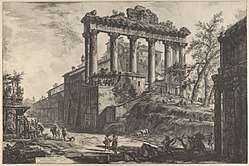
It is hard to recapture the radical and exciting nature of early Neoclassical painting for contemporary audiences; it now strikes even those writers favourably inclined to it as "insipid" and "almost entirely uninteresting to us"—some of Kenneth Clark's comments on Anton Raphael Mengs' ambitious Parnassus at the Villa Albani,[17] by the artist who his friend Winckelmann described as "the greatest artist of his own, and perhaps of later times".[18] The drawings, subsequently turned into prints, of John Flaxman used very simple line drawing (thought to be the purest classical medium[19]) and figures mostly in profile to depict The Odyssey and other subjects, and once "fired the artistic youth of Europe" but are now "neglected",[20] while the history paintings of Angelica Kauffman, mainly a portraitist, are described as having "an unctuous softness and tediousness" by Fritz Novotny.[21] Rococo frivolity and Baroque movement had been stripped away but many artists struggled to put anything in their place, and in the absence of ancient examples for history painting, other than the Greek vases used by Flaxman, Raphael tended to be used as a substitute model, as Winckelmann recommended.
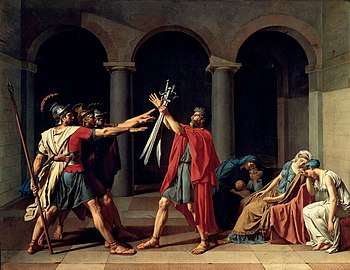
The work of other artists, who could not easily be described as insipid, combined aspects of Romanticism with a generally Neoclassical style, and form part of the history of both movements. The German-Danish painter Asmus Jacob Carstens finished very few of the large mythological works that he planned, leaving mostly drawings and colour studies which often succeed in approaching Winckelmann's prescription of "noble simplicity and calm grandeur".[22] Unlike Carstens' unrealized schemes, the etchings of Giovanni Battista Piranesi were numerous and profitable, and taken back by those making the Grand Tour to all parts of Europe. His main subject matter was the buildings and ruins of Rome, and he was more stimulated by the ancient than the modern. The somewhat disquieting atmosphere of many of his Vedute (views) becomes dominant in his series of 16 prints of Carceri d'Invenzione ("Imaginary Prisons") whose "oppressive cyclopean architecture" conveys "dreams of fear and frustration".[23] The Swiss-born Johann Heinrich Füssli spent most of his career in England, and while his fundamental style was based on Neoclassical principles, his subjects and treatment more often reflected the "Gothic" strain of Romanticism, and sought to evoke drama and excitement.
Neoclassicism in painting gained a new sense of direction with the sensational success of Jacques-Louis David's Oath of the Horatii at the Paris Salon of 1785. Despite its evocation of republican virtues, this was a commission by the royal government, which David insisted on painting in Rome. David managed to combine an idealist style with drama and forcefulness. The central perspective is perpendicular to the picture plane, made more emphatic by the dim arcade behind, against which the heroic figures are disposed as in a frieze, with a hint of the artificial lighting and staging of opera, and the classical colouring of Nicholas Poussin. David rapidly became the leader of French art, and after the French Revolution became a politician with control of much government patronage in art. He managed to retain his influence in the Napoleonic period, turning to frankly propagandistic works, but had to leave France for exile in Brussels at the Bourbon Restoration.[24]
David's many students included Jean-Auguste-Dominique Ingres, who saw himself as a classicist throughout his long career, despite a mature style that has an equivocal relationship with the main current of Neoclassicism, and many later diversions into Orientalism and the Troubadour style that are hard to distinguish from those of his unabashedly Romantic contemporaries, except by the primacy his works always give to drawing. He exhibited at the Salon for over 60 years, from 1802 into the beginnings of Impressionism, but his style, once formed, changed little.[25]
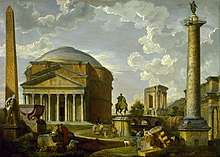 Fantasy view with the Pantheon and other monuments of Ancient Rome, an example of a capriccio; 1737; oil on canvas; 98.9 x 137.49 cm; Museum of Fine Arts (Huston, US)
Fantasy view with the Pantheon and other monuments of Ancient Rome, an example of a capriccio; 1737; oil on canvas; 98.9 x 137.49 cm; Museum of Fine Arts (Huston, US)_MET_DP827988.jpg) Large sculpture gallery built on arches and lit from above . . .; by Giovanni Battista Piranesi; circa 1750; etching; size of the entire sheet: 49.4 × 33.5 cm; Metropolitan Museum of Art (New York City)
Large sculpture gallery built on arches and lit from above . . .; by Giovanni Battista Piranesi; circa 1750; etching; size of the entire sheet: 49.4 × 33.5 cm; Metropolitan Museum of Art (New York City)_MET_DP827987.jpg) The ancient Capitol ascended by approximately one hundred steps . . .; by Giovanni Battista Piranesi; circa 1750; etching; size of the entire sheet: 33.5 × 49.4 cm; Metropolitan Museum of Art
The ancient Capitol ascended by approximately one hundred steps . . .; by Giovanni Battista Piranesi; circa 1750; etching; size of the entire sheet: 33.5 × 49.4 cm; Metropolitan Museum of Art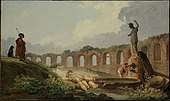 Aqueduct in Ruins; by Hubert Robert; 18th century; oil on canvas; 81.6 x 137.5 cm; Metropolitan Museum of Art
Aqueduct in Ruins; by Hubert Robert; 18th century; oil on canvas; 81.6 x 137.5 cm; Metropolitan Museum of Art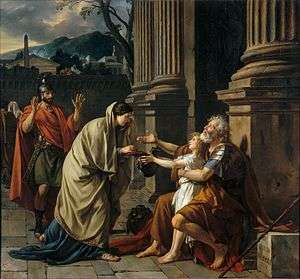 Belisarius Begging for Alms; by Jacques-Louis David; 1781; oil on canvas; 288 x 312 cm; Palais des Beaux-Arts de Lille (Lille, France)
Belisarius Begging for Alms; by Jacques-Louis David; 1781; oil on canvas; 288 x 312 cm; Palais des Beaux-Arts de Lille (Lille, France) The Death of Socrates; by Jacques-Louis David; 1787; oil on canvas; 129.5 cm × 196.2 cm; Metropolitan Museum of Art
The Death of Socrates; by Jacques-Louis David; 1787; oil on canvas; 129.5 cm × 196.2 cm; Metropolitan Museum of Art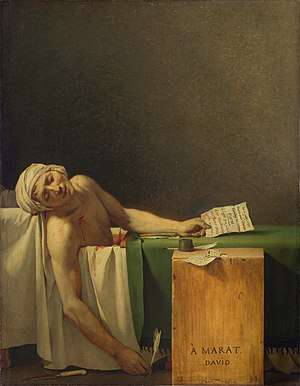 The Death of Marat; by Jacques-Louis David; 1793; oil on canvas; 165 x 128 cm; Royal Museums of Fine Arts of Belgium (Bruxelles)
The Death of Marat; by Jacques-Louis David; 1793; oil on canvas; 165 x 128 cm; Royal Museums of Fine Arts of Belgium (Bruxelles)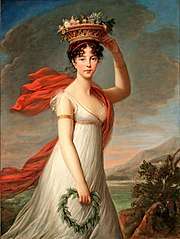 Julie Lebrun as Flora; by Élisabeth Vigée Le Brun; circa 1799; oil on canvas; 129.5 x 97.8 cm; Museum of Fine Arts (St. Petersburg, Florida, US)
Julie Lebrun as Flora; by Élisabeth Vigée Le Brun; circa 1799; oil on canvas; 129.5 x 97.8 cm; Museum of Fine Arts (St. Petersburg, Florida, US)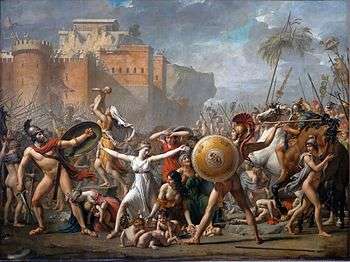 The Intervention of the Sabine Women; by Jacques-Louis David; 1799; oil on canvas; 385 x 522 cm; Louvre
The Intervention of the Sabine Women; by Jacques-Louis David; 1799; oil on canvas; 385 x 522 cm; Louvre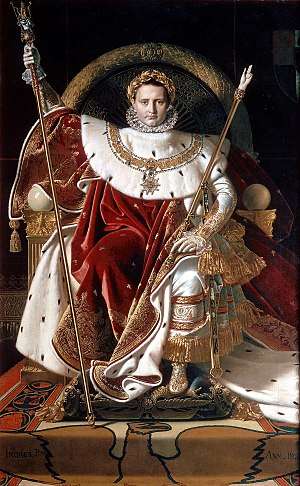 Napoleon I on His Imperial Throne; by Jean Auguste Dominique Ingres; 1806; oil on canvas; 259 x 162 cm; Army Museum (Paris)
Napoleon I on His Imperial Throne; by Jean Auguste Dominique Ingres; 1806; oil on canvas; 259 x 162 cm; Army Museum (Paris).jpg) The Coronation of Napoleon; by Jacques-Louis David; 1805–1807; oil on canvas; 6.21 × 9.79 m; Louvre
The Coronation of Napoleon; by Jacques-Louis David; 1805–1807; oil on canvas; 6.21 × 9.79 m; Louvre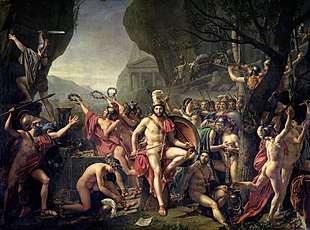 Leonidas at Thermopylae; by Jacques-Louis David; 1814; oil on canvas; 395 × 531 cm; Louvre
Leonidas at Thermopylae; by Jacques-Louis David; 1814; oil on canvas; 395 × 531 cm; Louvre
Sculpture
If Neoclassical painting suffered from a lack of ancient models, Neoclassical sculpture tended to suffer from an excess of them, although examples of actual Greek sculpture of the "classical period" beginning in about 500 BC were then very few; the most highly regarded works were mostly Roman copies.[26] The leading Neoclassical sculptors enjoyed huge reputations in their own day, but are now less regarded, with the exception of Jean-Antoine Houdon, whose work was mainly portraits, very often as busts, which do not sacrifice a strong impression of the sitter's personality to idealism. His style became more classical as his long career continued, and represents a rather smooth progression from Rococo charm to classical dignity. Unlike some Neoclassical sculptors he did not insist on his sitters wearing Roman dress, or being unclothed. He portrayed most of the great figures of the Enlightenment, and travelled to America to produce a statue of George Washington, as well as busts of Thomas Jefferson, Ben Franklin and other luminaries of the new republic.[27][28]
Antonio Canova and the Dane Bertel Thorvaldsen were both based in Rome, and as well as portraits produced many ambitious life-size figures and groups; both represented the strongly idealizing tendency in Neoclassical sculpture. Canova has a lightness and grace, where Thorvaldsen is more severe; the difference is exemplified in their respective groups of the Three Graces.[29] All these, and Flaxman, were still active in the 1820s, and Romanticism was slow to impact sculpture, where versions of Neoclassicism remained the dominant style for most of the 19th century.
An early Neoclassicist in sculpture was the Swede Johan Tobias Sergel.[30] John Flaxman was also, or mainly, a sculptor, mostly producing severely classical reliefs that are comparable in style to his prints; he also designed and modelled Neoclassical ceramics for Josiah Wedgwood for several years. Johann Gottfried Schadow and his son Rudolph, one of the few Neoclassical sculptors to die young, were the leading German artists,[31] with Franz Anton von Zauner in Austria. The late Baroque Austrian sculptor Franz Xaver Messerschmidt turned to Neoclassicism in mid-career, shortly before he appears to have suffered some kind of mental crisis, after which he retired to the country and devoted himself to the highly distinctive "character heads" of bald figures pulling extreme facial expressions.[32] Like Piranesi's Carceri, these enjoyed a great revival of interest during the age of psychoanalysis in the early 20th century. The Dutch Neoclassical sculptor Mathieu Kessels studied with Thorvaldsen and worked almost exclusively in Rome.
Since prior to the 1830s the United States did not have a sculpture tradition of its own, save in the areas of tombstones, weathervanes and ship figureheads,[33] the European Neoclassical manner was adopted there, and it was to hold sway for decades and is exemplified in the sculptures of Horatio Greenough, Harriet Hosmer, Hiram Powers, Randolph Rogers and William Henry Rinehart.
- Poetry and Music; by Claude Michel, called Clodion; circa 1774–1778; marble; National Gallery of Art (Washington, D.C.)
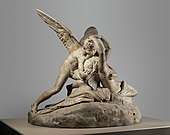 Cupid and Psyche; by Antonio Canova; 1794; plaster; overall: 134.6 × 151.1 × 81.3 cm; Metropolitan Museum of Art (New York City)
Cupid and Psyche; by Antonio Canova; 1794; plaster; overall: 134.6 × 151.1 × 81.3 cm; Metropolitan Museum of Art (New York City)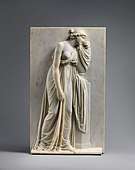 Artemisia in mourning; by Philipp Jakob Scheffauer; 1794; marble; height: 50.2 cm, width: 30 cm, depth: 5 cm; Metropolitan Museum of Art
Artemisia in mourning; by Philipp Jakob Scheffauer; 1794; marble; height: 50.2 cm, width: 30 cm, depth: 5 cm; Metropolitan Museum of Art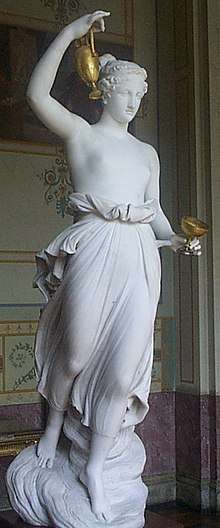 Hebe by Antonio Canova; 1800–1805; marble; height: 158 cm; in the appropriately Neoclassical surroundings of the Hermitage Museum (Saint Petersburg, Russia)
Hebe by Antonio Canova; 1800–1805; marble; height: 158 cm; in the appropriately Neoclassical surroundings of the Hermitage Museum (Saint Petersburg, Russia)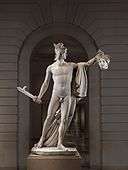
.jpg)
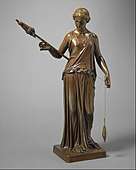 Filatrice; by Henry Kirke Brown; 1850; bronze; 50.8 x 30.5 x 20.3 cm; Metropolitan Museum of Art
Filatrice; by Henry Kirke Brown; 1850; bronze; 50.8 x 30.5 x 20.3 cm; Metropolitan Museum of Art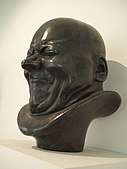 One of the "character heads" of Franz Xaver Messerschmidt
One of the "character heads" of Franz Xaver Messerschmidt
Architecture and the decorative arts
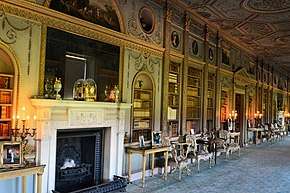
Neoclassical art was traditional and new, historical and modern, conservative and progressive all at the same time.[34]
Neoclassicism first gained influence in England and France, through a generation of French art students trained in Rome and influenced by the writings of Winckelmann, and it was quickly adopted by progressive circles in other countries such as Sweden, Poland and Russia. At first, classicizing decor was grafted onto familiar European forms, as in the interiors for Catherine II's lover, Count Orlov, designed by an Italian architect with a team of Italian stuccadori: only the isolated oval medallions like cameos and the bas-relief overdoors hint of Neoclassicism; the furnishings are fully Italian Rococo.
A second Neoclassic wave, more severe, more studied (through the medium of engravings) and more consciously archaeological, is associated with the height of the Napoleonic Empire. In France, the first phase of Neoclassicism was expressed in the "Louis XVI style", and the second in the styles called "Directoire" or Empire. The Rococo style remained popular in Italy until the Napoleonic regimes brought the new archaeological classicism, which was embraced as a political statement by young, progressive, urban Italians with republican leanings.
In the decorative arts, Neoclassicism is exemplified in Empire furniture made in Paris, London, New York, Berlin; in Biedermeier furniture made in Austria; in Karl Friedrich Schinkel's museums in Berlin, Sir John Soane's Bank of England in London and the newly built "capitol" in Washington, D.C.; and in Wedgwood's bas reliefs and "black basaltes" vases. The style was international; Scots architect Charles Cameron created palatial Italianate interiors for the German-born Catherine II the Great, in Russian St. Petersburg.
Indoors, Neoclassicism made a discovery of the genuine classic interior, inspired by the rediscoveries at Pompeii and Herculaneum. These had begun in the late 1740s, but only achieved a wide audience in the 1760s,[35] with the first luxurious volumes of tightly controlled distribution of Le Antichità di Ercolano (The Antiquities of Herculaneum). The antiquities of Herculaneum showed that even the most classicizing interiors of the Baroque, or the most "Roman" rooms of William Kent were based on basilica and temple exterior architecture turned outside in, hence their often bombastic appearance to modern eyes: pedimented window frames turned into gilded mirrors, fireplaces topped with temple fronts. The new interiors sought to recreate an authentically Roman and genuinely interior vocabulary.
Techniques employed in the style included flatter, lighter motifs, sculpted in low frieze-like relief or painted in monotones en camaïeu ("like cameos"), isolated medallions or vases or busts or bucrania or other motifs, suspended on swags of laurel or ribbon, with slender arabesques against backgrounds, perhaps, of "Pompeiian red" or pale tints, or stone colors. The style in France was initially a Parisian style, the Goût grec ("Greek style"), not a court style; when Louis XVI acceded to the throne in 1774, Marie Antoinette, his fashion-loving Queen, brought the "Louis XVI" style to court. However, there was no real attempt to employ the basic forms of Roman furniture until around the turn of the century, and furniture-makers were more likely to borrow from ancient architecture, just as silversmiths were more likely to take from ancient pottery and stone-carving than metalwork: "Designers and craftsmen ... seem to have taken an almost perverse pleasure in transferring motifs from one medium to another".[36]
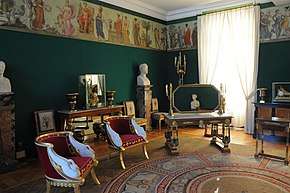
From about 1800 a fresh influx of Greek architectural examples, seen through the medium of etchings and engravings, gave a new impetus to Neoclassicism, the Greek Revival. At the same time the Empire style was a more grandiose wave of Neoclassicism in architecture and the decorative arts. Mainly based on Imperial Roman styles, it originated in, and took its name from, the rule of Napoleon in the First French Empire, where it was intended to idealize Napoleon's leadership and the French state. The style corresponds to the more bourgeois Biedermeier style in the German-speaking lands, Federal style in the United States,[35] the Regency style in Britain, and the Napoleon style in Sweden. According to the art historian Hugh Honour "so far from being, as is sometimes supposed, the culmination of the Neo-classical movement, the Empire marks its rapid decline and transformation back once more into a mere antique revival, drained of all the high-minded ideas and force of conviction that had inspired its masterpieces".[37] An earlier phase of the style was called the Adam style in Great Britain and "Louis Seize", or Louis XVI, in France.
Neoclassicism continued to be a major force in academic art through the 19th century and beyond—a constant antithesis to Romanticism or Gothic revivals —, although from the late 19th century on it had often been considered anti-modern, or even reactionary, in influential critical circles. The centres of several European cities, notably St. Petersburg and Munich, came to look much like museums of Neoclassical architecture.
Gothic revival architecture (often linked with the Romantic cultural movement), a style originating in the 18th century which grew in popularity throughout the 19th century, contrasted Neoclassicism. Whilst Neoclassicism was characterized by Greek and Roman-influenced styles, geometric lines and order, Gothic revival architecture placed an emphasis on medieval-looking buildings, often made to have a rustic, "romantic" appearance.
.jpg)
 Plate with various ornaments and patterns; 1772–1777; brush and watercolor and gouache over etching on white wove paper; Cooper Hewitt, Smithsonian Design Museum (New York City)
Plate with various ornaments and patterns; 1772–1777; brush and watercolor and gouache over etching on white wove paper; Cooper Hewitt, Smithsonian Design Museum (New York City)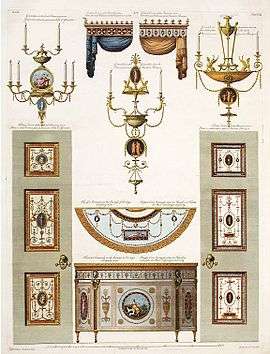 Details for the interiors of Derby House (26 Grosvenor Square) by Robert and James Adam, published in 1777
Details for the interiors of Derby House (26 Grosvenor Square) by Robert and James Adam, published in 1777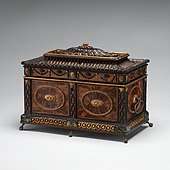 British tea chest; circa 1780; mahogany and satinwood veneer, parcel gilt and inset with marble; overall: 22.9 × 29.2 × 16.5 cm; Metropolitan Museum of Art (New York City)
British tea chest; circa 1780; mahogany and satinwood veneer, parcel gilt and inset with marble; overall: 22.9 × 29.2 × 16.5 cm; Metropolitan Museum of Art (New York City)_MET_DP103165_(cropped).jpg) Pair of vases with covers; made at the Real Fábrica del Buen Retiro; 1784–1795; soft-paste porcelain; height (with cover): 47.6 cm; Metropolitan Museum of Art
Pair of vases with covers; made at the Real Fábrica del Buen Retiro; 1784–1795; soft-paste porcelain; height (with cover): 47.6 cm; Metropolitan Museum of Art- Italian chest of drawers; by Giuseppe Maggiolini; 1790s; Antique Furniture & Wooden Sculpture Museum (Milan, Italy)
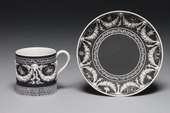 Neoclassical coffee cup with saucer; circa 1790; jasper ware with relief decoration; diameter: 13.6 cm; by the Wedgwood Factory (England); Cleveland Museum of Art (Cleveland, US)
Neoclassical coffee cup with saucer; circa 1790; jasper ware with relief decoration; diameter: 13.6 cm; by the Wedgwood Factory (England); Cleveland Museum of Art (Cleveland, US)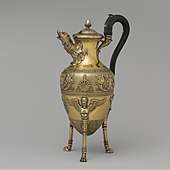 French coffeepot; 1797-1809; silver gilt; height: 33.3 cm; Metropolitan Museum of Art
French coffeepot; 1797-1809; silver gilt; height: 33.3 cm; Metropolitan Museum of Art_MET_DP278961.jpg) Desk chair (fauteuil de bureau); 1805–1808; mahogany, gilt bronze and satin-velvet upholstery; 87.6 × 59.7 × 64.8 cm; Metropolitan Museum of Art
Desk chair (fauteuil de bureau); 1805–1808; mahogany, gilt bronze and satin-velvet upholstery; 87.6 × 59.7 × 64.8 cm; Metropolitan Museum of Art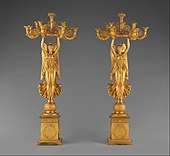 Pair of Empire candelabra with Winged Victories; 1810–1815; gilt bronze; height (each): 127.6 cm; Metropolitan Museum of Art
Pair of Empire candelabra with Winged Victories; 1810–1815; gilt bronze; height (each): 127.6 cm; Metropolitan Museum of Art- English pedestal table; c. 1810; mahogany and ebony with metal inlays and gilt bronze; Art Institute of Chicago (US)
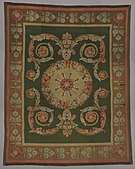 French carpet; 1814–1830; 309.9 × 246.4 cm; Metropolitan Museum of Art
French carpet; 1814–1830; 309.9 × 246.4 cm; Metropolitan Museum of Art Vase in the style of Greek red-figure pottery; circa 1815; wedgwood; height: 28.5 cm, width: 22.8 cm
Vase in the style of Greek red-figure pottery; circa 1815; wedgwood; height: 28.5 cm, width: 22.8 cm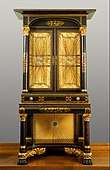 Secretary-bookcase; 1825-1835; mahogany and various materials; 259.1 x 141.6 x 71.4 cm; Metropolitan Museum of Art
Secretary-bookcase; 1825-1835; mahogany and various materials; 259.1 x 141.6 x 71.4 cm; Metropolitan Museum of Art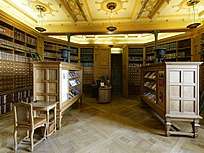 The Catalog Room of the Bibliothèque Mazarine, in Paris
The Catalog Room of the Bibliothèque Mazarine, in Paris.jpg)
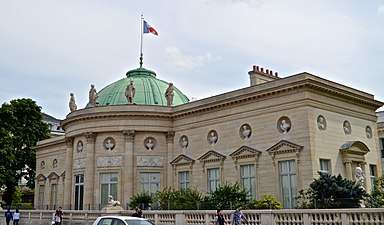 The Palais de la Légion d'Honneur, on the Left Bank of the River Seine in Paris
The Palais de la Légion d'Honneur, on the Left Bank of the River Seine in Paris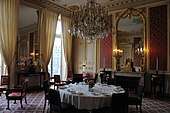 Salon Empire of the Hôtel de Bourvallais (Paris)
Salon Empire of the Hôtel de Bourvallais (Paris)
Neoclassical gardens
In England, Augustan literature had a direct parallel with the Augustan style of landscape design. The links are clearly seen in the work of Alexander Pope. The best surviving examples of Neoclassical English gardens are Chiswick House, Stowe House and Stourhead.[38]
Neoclassicism and fashion
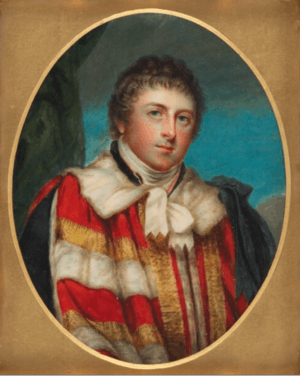
In fashion, Neoclassicism influenced the much greater simplicity of women's dresses, and the long-lasting fashion for white, from well before the French Revolution, but it was not until after it that thorough-going attempts to imitate ancient styles became fashionable in France, at least for women. Classical costumes had long been worn by fashionable ladies posing as some figure from Greek or Roman myth in a portrait (in particular there was a rash of such portraits of the young model Emma, Lady Hamilton from the 1780s), but such costumes were only worn for the portrait sitting and masquerade balls until the Revolutionary period, and perhaps, like other exotic styles, as undress at home. But the styles worn in portraits by Juliette Récamier, Joséphine de Beauharnais, Thérésa Tallien and other Parisian trend-setters were for going-out in public as well. Seeing Mme Tallien at the opera, Talleyrand quipped that: "Il n'est pas possible de s'exposer plus somptueusement!" ("One could not be more sumptuously undressed"). In 1788, just before the Revolution, the court portraitist Louise Élisabeth Vigée Le Brun had held a Greek supper where the ladies wore plain white Grecian tunics.[39] Shorter classical hairstyles, where possible with curls, were less controversial and very widely adopted, and hair was now uncovered even outdoors; except for evening dress, bonnets or other coverings had typically been worn even indoors before. Thin Greek-style ribbons or fillets were used to tie or decorate the hair instead.
Very light and loose dresses, usually white and often with shockingly bare arms, rose sheer from the ankle to just below the bodice, where there was a strongly emphasized thin hem or tie round the body, often in a different colour. The shape is now often known as the Empire silhouette although it predates the First French Empire of Napoleon, but his first Empress Joséphine de Beauharnais was influential in spreading it around Europe. A long rectangular shawl or wrap, very often plain red but with a decorated border in portraits, helped in colder weather, and was apparently laid around the midriff when seated—for which sprawling semi-recumbent postures were favoured.[40] By the start of the 19th century, such styles had spread widely across Europe.
Neoclassical fashion for men was far more problematic, and never really took off other than for hair, where it played an important role in the shorter styles that finally despatched the use of wigs, and then white hair-powder, for younger men. The trouser had been the symbol of the barbarian to the Greeks and Romans, but outside the painter's or, especially, the sculptor's studio, few men were prepared to abandon it. Indeed, the period saw the triumph of the pure trouser, or pantaloon, over the cullottes or knee-breeches of the Ancien Régime. Even when David designed a new French "national costume" at the request of the government during the height of the Revolutionary enthusiasm for changing everything in 1792, it included fairly tight leggings under a coat that stopped above the knee. A high proportion of well-to-do young men spent much of the key period in military service because of the French Revolutionary Wars, and military uniform, which began to emphasize jackets that were short at the front, giving a full view of tight-fitting trousers, was often worn when not on duty, and influenced cilivian male styles.
The trouser-problem had been recognised by artists as a barrier to creating contemporary history paintings; like other elements of contemporary dress they were seen as irredeemably ugly and unheroic by many artists and critics. Various strategems were used to avoid depicting them in modern scenes. In James Dawkins and Robert Wood Discovering the Ruins of Palmyra (1758) by Gavin Hamilton, the two gentleman antiquaries are shown in toga-like Arab robes. In Watson and the Shark (1778) by John Singleton Copley, the main figure could plausibly be shown nude, and the composition is such that of the eight other men shown, only one shows a single breeched leg prominently. However the Americans Copley and Benjamin West led the artists who successfully showed that trousers could be used in heroic scenes, with works like West's The Death of General Wolfe (1770) and Copley's The Death of Major Peirson, 6 January 1781 (1783), although the trouser was still being carefully avoided in The Raft of the Medusa, completed in 1819.
Classically inspired male hair styles included the Bedford Crop, arguably the precursor of most plain modern male styles, which was invented by the radical politician Francis Russell, 5th Duke of Bedford as a protest against a tax on hair powder; he encouraged his friends to adopt it by betting them they would not. Another influential style (or group of styles) was named by the French "à la Titus" after Titus Junius Brutus (not in fact the Roman Emperor Titus as often assumed), with hair short and layered but somewhat piled up on the crown, often with restrained quiffs or locks hanging down; variants are familiar from the hair of both Napoleon and George IV of England. The style was supposed to have been introduced by the actor François-Joseph Talma, who upstaged his wigged co-actors when appearing in productions of works such as Voltaire's Brutus (about Lucius Junius Brutus, who orders the execution of his son Titus). In 1799 a Parisian fashion magazine reported that even bald men were adopting Titus wigs,[41] and the style was also worn by women, the Journal de Paris reporting in 1802 that "more than half of elegant women were wearing their hair or wig à la Titus.[42]
- James Dawkins and Robert Wood Discovering the Ruins of Palmyra, by Gavin Hamilton (1758)
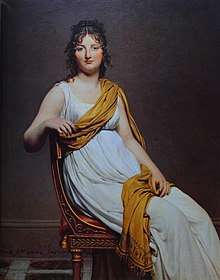 Madame Raymond de Verninac by Jacques-Louis David, with clothes and chair in Directoire style. "Year 7": that is, 1798–99.
Madame Raymond de Verninac by Jacques-Louis David, with clothes and chair in Directoire style. "Year 7": that is, 1798–99.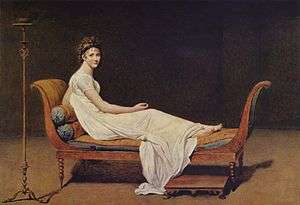 Portrait of Madame Récamier, David, 1800
Portrait of Madame Récamier, David, 1800.jpg) Elizabeth Alexeievna, Empress of Russia and no political radical, in 1802
Elizabeth Alexeievna, Empress of Russia and no political radical, in 1802
Later Neoclassicism
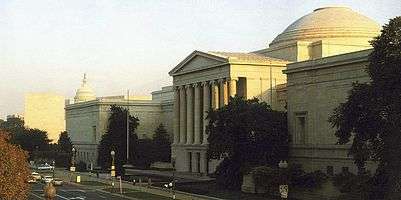
| Part of a series on |
| Classicism |
|---|
| Classical antiquity |
| Age of Enlightenment |
| 20th-century neoclassicism |
|
In American architecture, Neoclassicism was one expression of the American Renaissance movement, ca. 1890–1917; its last manifestation was in Beaux-Arts architecture, and its very last, large public projects were the Lincoln Memorial (highly criticized at the time), the National Gallery of Art in Washington, D.C. (also heavily criticized by the architectural community as being backward thinking and old fashioned in its design), and the American Museum of Natural History's Roosevelt Memorial. These were considered stylistic anachronisms when they were finished. In the British Raj, Sir Edwin Lutyens' monumental city planning for New Delhi marks the glorious sunset of Neoclassicism. World War II was to shatter most longing for (and imitation of) mythical, heroic times.
Conservative modernist architects such as Auguste Perret in France kept the rhythms and spacing of columnar architecture even in factory buildings. Where a colonnade would have been decried as "reactionary", a building's pilaster-like fluted panels under a repeating frieze looked "progressive". Pablo Picasso experimented with classicizing motifs in the years immediately following World War I, and the Art Deco style that came to the fore following the 1925 Paris Exposition des Arts Décoratifs, often drew on Neoclassical motifs without expressing them overtly: severe, blocky commodes by É.-J. Ruhlmann or Süe & Mare; crisp, extremely low-relief friezes of damsels and gazelles in every medium; fashionable dresses that were draped or cut on the bias to recreate Grecian lines; the art dance of Isadora Duncan; the Streamline Moderne styling of U.S. post offices and county court buildings built as late as 1950; and the Roosevelt dime.
There was an entire 20th-century movement in the Arts which was also called Neo-classicism. It encompassed at least music, philosophy and literature. It was between the end of World War I and the end of World War II. (For information on the musical aspects, see 20th-century classical music and Neoclassicism in music. For information on the philosophical aspects, see Great Books.)
This literary Neoclassical movement rejected the extreme romanticism of (for example) Dada, in favour of restraint, religion (specifically Christianity) and a reactionary political program. Although the foundations for this movement in English literature were laid by T. E. Hulme, the most famous Neoclassicists were T. S. Eliot and Wyndham Lewis. In Russia, the movement crystallized as early as 1910 under the name of Acmeism, with Anna Akhmatova and Osip Mandelshtam as the leading representatives.
In music
Neoclassicism in music is a 20th-century movement; in this case it is the Classical and Baroque musical styles of the 17th and 18th centuries, with their fondness for Greek and Roman themes, that were being revived, not the music of the ancient world itself. (The early 20th century had not yet distinguished the Baroque period in music, on which Neoclassical composers mainly drew, from what we now call the Classical period.) The movement was a reaction in the first part of the 20th century to the disintegrating chromaticism of late-Romanticism and Impressionism, emerging in parallel with musical Modernism, which sought to abandon key tonality altogether. It manifested a desire for cleanness and simplicity of style, which allowed for quite dissonant paraphrasing of classical procedures, but sought to blow away the cobwebs of Romanticism and the twilit glimmerings of Impressionism in favour of bold rhythms, assertive harmony and clean-cut sectional forms, coinciding with the vogue for reconstructed "classical" dancing and costume in ballet and physical education.
The 17th-18th century dance suite had had a minor revival before World War I but the Neoclassicists were not altogether happy with unmodified diatonicism, and tended to emphasise the bright dissonance of suspensions and ornaments, the angular qualities of 17th-century modal harmony and the energetic lines of countrapuntal part-writing. Respighi's Ancient Airs and Dances (1917) led the way for the sort of sound to which the Neoclassicists aspired. Although the practice of borrowing musical styles from the past has not been uncommon throughout musical history, art musics have gone through periods where musicians used modern techniques coupled with older forms or harmonies to create new kinds of works. Notable compositional characteristics are: referencing diatonic tonality, conventional forms (dance suites, concerti grossi, sonata forms, etc.), the idea of absolute music untramelled by descriptive or emotive associations, the use of light musical textures, and a conciseness of musical expression. In classical music, this was most notably perceived between the 1920s and the 1950s. Igor Stravinsky is the best-known composer using this style; he effectively began the musical revolution with his Bach-like Octet for Wind Instruments (1923). A particular individual work that represents this style well is Prokofiev's Classical Symphony No. 1 in D, which is reminiscent of the symphonic style of Haydn or Mozart. Neoclassical ballet as innovated by George Balanchine de-cluttered the Russian Imperial style in terms of costume, steps and narrative, while also introducing technical innovations.
Architecture in Russia and the Soviet Union
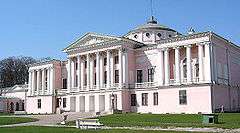
In 1905–1914 Russian architecture passed through a brief but influential period of Neoclassical revival; the trend began with recreation of Empire style of alexandrine period and quickly expanded into a variety of neo-Renaissance, palladian and modernized, yet recognizably classical schools. They were led by architects born in the 1870s, who reached creative peak before World War I, like Ivan Fomin, Vladimir Shchuko and Ivan Zholtovsky. When economy recovered in the 1920s, these architects and their followers continued working in primarily modernist environment; some (Zholtovsky) strictly followed the classical canon, others (Fomin, Schuko, Ilya Golosov) developed their own modernized styles.[43]
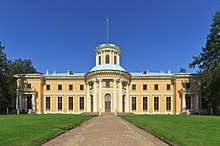
With the crackdown on architects' independence and official denial of modernism (1932), demonstrated by the international contest for the Palace of Soviets, Neoclassicism was instantly promoted as one of the choices in Stalinist architecture, although not the only one. It coexisted with moderately modernist architecture of Boris Iofan, bordering with contemporary Art Deco (Schuko); again, the purest examples of the style were produced by Zholtovsky school that remained an isolated phenomena. The political intervention was a disaster for constructivist leaders yet was sincerely welcomed by architects of the classical schools.
Neoclassicism was an easy choice for the USSR since it did not rely on modern construction technologies (steel frame or reinforced concrete) and could be reproduced in traditional masonry. Thus the designs of Zholtovsky, Fomin and other old masters were easily replicated in remote towns under strict material rationing. Improvement of construction technology after World War II permitted Stalinist architects to venture into skyscraper construction, although stylistically these skyscrapers (including "exported" architecture of Palace of Culture and Science, Warsaw and the Shanghai International Convention Centre) share little with the classical models. Neoclassicism and neo-Renaissance persisted in less demanding residential and office projects until 1955, when Nikita Khrushchev put an end to expensive Stalinist architecture.
Architecture in the 21st century
After a lull during the period of modern architectural dominance (roughly post-World War II until the mid-1980s), Neoclassicism has seen something of a resurgence.
As of the first decade of the 21st century, contemporary Neoclassical architecture is usually classed under the umbrella term of New Classical Architecture. Sometimes it is also referred to as Neo-Historicism or Traditionalism.[44] Also, a number of pieces of postmodern architecture draw inspiration from and include explicit references to Neoclassicism, Antigone District and the National Theatre of Catalonia in Barcelona among them. Postmodern architecture occasionally includes historical elements, like columns, capitals or the tympanum.
For sincere traditional-style architecture that sticks to regional architecture, materials and craftsmanship, the term Traditional Architecture (or vernacular) is mostly used. The Driehaus Architecture Prize is awarded to major contributors in the field of 21st century traditional or classical architecture, and comes with a prize money twice as high as that of the modernist Pritzker Prize.[45]
In the United States, various contemporary public buildings are built in Neoclassical style, with the 2006 Schermerhorn Symphony Center in Nashville being an example.
In Britain, a number of architects are active in the Neoclassical style. Examples of their work include two university libraries: Quinlan Terry's Maitland Robinson Library at Downing College and Robert Adam Architects' Sackler Library.
See also
- American Empire (style)
- Antiquization
- Nazi architecture
- Neoclassical architecture
- Neoclassicism in France
- Neo-Grec, the late Greek-Revival style
- 1795–1820 in Western fashion
- Skopje 2014
- Stalinist architecture
Notes
- "Etymology of the English word "neo-classical"". myetymology.com. Retrieved 2016-05-09.
- Stevenson, Angus (2010-08-19). Oxford Dictionary of English. ISBN 9780199571123.
- Kohle, Hubertus (August 7, 2006). "The road from Rome to Paris. The birth of a modern Neoclassicism". Jacques Louis David. New perspectives.
- Irwin, David G. (1997). Neoclassicism A&I (Art and Ideas). Phaidon Press. ISBN 978-0-7148-3369-9.
- Honour, 17-25; Novotny, 21
- A recurring theme in Clark: 19-23, 58-62, 69, 97-98 (on Ingres); Honour, 187-190; Novotny, 86-87
- Lingo, Estelle Cecile (2007). François Duquesnoy and the Greek ideal. Yale University Press; First Edition. pp. 161. ISBN 978-0-300-12483-5.
- Talbott, Page (1995). Classical Savannah: fine & decorative arts, 1800-1840. University of Georgia Press. p. 6. ISBN 978-0-8203-1793-9.
- Cunningham, Reich, Lawrence S., John J. (2009). Culture and values: a survey of the humanities. Wadsworth Publishing; 7 edition. p. 104. ISBN 978-0-495-56877-3.
- Honour, 57-62, 61 quoted
- Both quotes from the first pages of "Thoughts on the Imitation of Greek Works in Painting and Sculpture"
- Dyson, Stephen L. (2006). In Pursuit of Ancient Pasts: A History of Classical Archaeology in the Nineteenth and Twentieth Centuries. Yale University Press. pp. xii. ISBN 978-0-300-11097-5.
- Honour, 21
- Honour, 11, 23-25
- Honour, 44-46; Novotny, 21
- Honour, 43-62
- Clark, 20 (quoted); Honour, 14; image of the painting (in fairness, other works by Mengs are more successful)
- Honour, 31-32 (31 quoted)
- Honour, 113-114
- Honour, 14
- Novotny, 62
- Novotny, 51-54
- Clark, 45-58 (47-48 quoted); Honour, 50-57
- Honour, 34-37; Clark, 21-26; Novotny, 19-22
- Novotny, 39-47;Clark, 97-145; Honour, 187-190
- Novotny, 378
- Novotny, 378–379
- Chinard, Gilbert, ed., Houdon in America Arno PressNy, 1979, a reprint of a book published by Johns Hopkins University, 1930
- Novotny, 379-384
- Novotny, 384-385
- Novotny, 388-389
- Novotny, 390-392
- Gerdts, William H., American Neo-Classic Sculpture: The Marble Resurrection, Viking Press, New York, 1973 p. 11
- Palmer, Alisson Lee. Historical dictionary of neoclassical art and architecture. p. 1.
- Gontar
- Honour, 110–111, 110 quoted
- Honour, 171–184, 171 quoted
- Turner, Turner (2013). British gardens: history, philosophy and design, Chapter 6 Neoclassical gardens and landscapes 1730-1800. London: Routledge. p. 456. ISBN 978-0415518789.
- Hunt, 244
- Hunt, 244-245
- Hunt, 243
- Rifelj, 35
- "The Origins of Modernism in Russian Architecture". Content.cdlib.org. Retrieved 2012-02-12.
- "Neo-classicist Architecture. Traditionalism. Historicism".
- Driehaus Prize for New Classical Architecture at Notre Dame SoA – Together, the $200,000 Driehaus Prize and the $50,000 Reed Award represent the most significant recognition for classicism in the contemporary built environment.; retained March 7, 2014
References
- Clark, Kenneth, The Romantic Rebellion: Romantic versus Classic Art, 1976, Omega. ISBN 0-86007-718-7.
- Honour, Hugh, Neo-classicism. Style and Civilisation 1968 (reprinted 1977), Penguin
- Gontar, Cybele, "Neoclassicism", In Heilbrunn Timeline of Art History. New York: The Metropolitan Museum of Art, 2000– online
- Hunt, Lynn, "Freedom of Dress in Revolutionary France", in From the Royal to the Republican Body: Incorporating the Political in Seventeenth- and Eighteenth-Century France, Editors: Sara E. Melzer, Kathryn Norberg, 1998, University of California Press, 1998, ISBN 0520208072,9780520208070
- Fritz Novotny, Painting and Sculpture in Europe, 1780–1880, 2nd edition (reprinted 1980).
- Rifelj, Carol De Dobay, Coiffures: Hair in Nineteenth-Century French Literature and Culture, 2010, University of Delaware Press, ISBN 0874130999, 9780874130997, google books
Further reading
- Brown, Kevin (2017). Artist and Patrons: Court Art and Revolution in Brussels at the end of the Ancien Regime, Dutch Crossing, Taylor and Francis
- Eriksen, Svend. Early Neoclassicism in France (1974)
- Friedlaender, Walter (1952). David to Delacroix (originally published in German; reprinted 1980)
- Gromort, Georges, with introductory essay by Richard Sammons (2001). The Elements of Classical Architecture (Classical America Series in Art and Architecture)
- Harrison, Charles; Paul Wood and Jason Gaiger (eds) (2000; repr. 2003). Art in Theory 1648–1815: An Anthology of Changing Ideas
- Hartop, Christopher, with foreword by Tim Knox (2010). The Classical Ideal: English Silver, 1760–1840, exh. cat. Cambridge: John Adamson ISBN 978-0-9524322-9-6
- Irwin, David (1966). English Neoclassical Art: Studies in Inspiration and Taste
- Johnson, James William. “What Was Neo-Classicism?” Journal of British Studies, vol. 9, no. 1, 1969, pp. 49–70. online
- Rosenblum, Robert (1967). Transformations in Late Eighteenth-Century Art
External links
| Wikimedia Commons has media related to Neoclassicism. |
